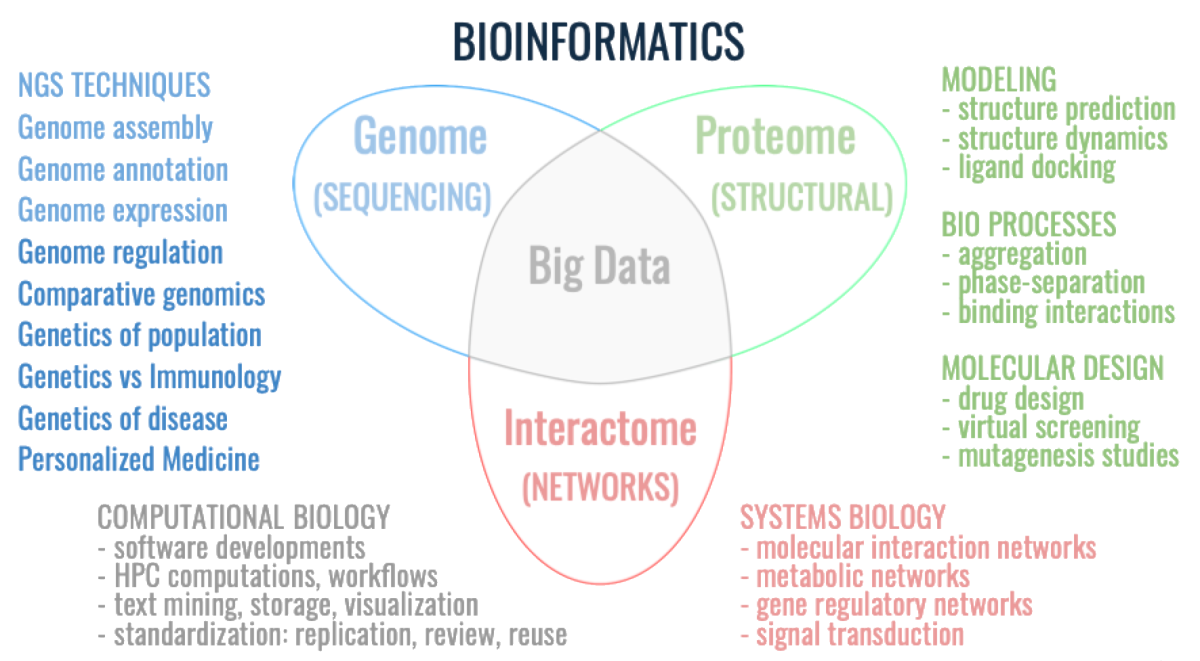DataScience Workbook / 01. Introduction to Data Science / 2. Applications of Computational Science / 2.1 Computational Biology
Introduction
Computational biology, also known as bioinformatics, is the intersection of biology, computer science, and information technology. It involves the use of computational tools and techniques to analyze and interpret large amounts of biological data quickly and accurately. Types of the processed data include DNA sequences, protein structures, and gene expression patterns. However, this data is often too complex and voluminous to be analyzed by hand, and this is where computational biology comes in. It enables developing algorithms and software tools that can handle biological data at a scale that would be impossible for humans to do manually.
One of the main goals of computational biology is to understand the underlying biological mechanisms of living systems and to use this knowledge to improve human health and the environment. For example, it helps scientists to:
- model and simulate complex biological systems,
- understand the role of proteins in various biological processes,
- identify genes and understand their functions,
- and design drugs that target specific proteins.
Overall, computational biology is an important field that has the potential to revolutionize our understanding of living systems.
Areas of applications
Computational biology plays a vital role in many areas of modern biology, including genomics, proteomics, and systems biology.
-
[SEQUENCING BIOINFORMATICS] In genomics, computational biology is used to analyze and interpret large-scale DNA sequencing data, such as the human genome. This information is used to identify genes and understand their functions, as well as to identify genetic variations that may be associated with certain diseases.
-
[STRUCTURAL BIONFORMATICS] In proteomics, computational biology is used to study the structure and function of proteins, which are the building blocks of living cells. This information is used to understand the role of proteins in various biological processes and to design drugs that target specific proteins.
-
[NETWORKS BIOINFORMATICS] In systems biology, computational biology is used to model and simulate complex biological systems, such as cellular networks and entire organisms. This helps scientists understand how different components of a biological system interact and how they contribute to the overall function of the system.

Bioinformatics Workbook
Sequencing Bioinformatics is a subfield of computational biology that involves the acquisition, storing, processing and visualizing of biological data such as DNA and RNA sequences. This type of data is generated in vast amounts with the advent of high-throughput sequencing technologies. It plays a crucial role in genomics, the study of the structure and function of genomes.
-
One of the main tasks of sequencing bioinformatics is to identify genes and understand their functions. This can be done by comparing DNA sequences to known gene sequences in databases [#reference genome, #model organism], and by predicting the functions of genes based on the sequences of the proteins they encode.
-
Another important task of sequencing bioinformatics is to identify genetic variations and measure gene expression that may be associated with certain diseases. For example, scientists can use DNA sequencing data to identify single nucleotide polymorphisms (SNPs) that are present in the genomes of people with a particular disease

One effective way to learn about sequencing bioinformatics is to study examples of real-world problems that are solved using computational tools and techniques. The Bioinformatics Workbook ⤴, available at https://bioinformaticsworkbook.org ⤴, is a useful resource for this purpose, as it provides a comprehensive overview of various aspects of generating & processing sequencing data, including experimental design, data acquisition, data wrangling, data analysis, and visualization. By working through these practical examples, readers can gain a deeper understanding of how bioinformatics is used to analyze and interpret biological data and how it can help us to better understand the underlying biological mechanisms of living systems.
Learn more…
- Bioinformatics Workbook - homepage ⤴
- About the Bioinformatics Workbook ⤴
- Detailed Table of Content ⤴
- Bioinformatics Glossary ⤴
- How to contribute? ⤴
